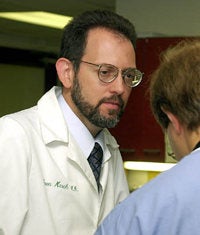Hispanics more likely to die in crashes, ECU study shows
GREENVILLE, N.C. (July 11, 2001) — On a rain-slickened road June 15, a car carrying six migrant farm workers from Guatemala skidded and collided with a pickup truck before coming to rest in a roadside ditch. A few minutes earlier, the car’s occupants had been going home after another work week. But after the crash, their bodies lay scattered near the car. According to investigators, the car’s tires lacked any significant tread, and none of the men wore a seatbelt.

Dr. Juan March. Photo by Cliff Hollis.
Highway Patrol officers described it as the worst crash scene they could recall. But a recently completed study by researchers at the Brody School of Medicine at East Carolina University could have predicted the outcome of such a crash. Led by Dr. Juan March, associate professor of emergency medicine and head of the ECU Department of Emergency Medicine’s division of emergency medical services, the team of researchers found that motor vehicle fatality rates among Hispanic motorists in Pitt County outpaced the fatality rates of white motorists by more than 10-to-1.
Reasons for the disparity include the fact that only 30 percent of Hispanics wear seatbelts, they drink and drive more often than other ethnic groups, Hispanic drivers are typically younger and they often speed, said March, a native of Cuba who moved to the United States at age 3.
March presented the study findings at the American College of Emergency Physicians research forum last October. He and his team published a broader study including statistics from across North Carolina in the May issue of Academic Emergency Medicine.
Nationally, deaths from motor vehicle crashes have fallen significantly in the last 30 years, from 52,627 in 1970 to 37,043 in 1999, the most recent year for which figures are available, according to the National Highway Traffic Safety Administration. The death rate has also fallen, from 4.7 deaths per 100 million vehicle miles in 1970 to 1.5 per 100 million vehicle miles in 1999. March, fellow ECU researcher Dr. Kori Brewer, medical resident Michael Evans and Brad Ward, a state highway patrol trooper, had a hunch that those decreasing rates did not apply to Hispanic motorists. They were right.
They looked at crash data from the N.C. Highway Patrol from July 1998 to July 1999, reviewing figures for the total number of crashes, crash deaths and seatbelt use for whites and Hispanics. After analyzing that information, they concluded that across North Carolina Hispanic motorists had a motor vehicle crash fatality rate of 31.7 per 100,000 population, compared to 15.4 for whites. They also found that in Pitt County Hispanics are more likely to die in crashes, at a rate of seven deaths per 221 crashes, compared to seven deaths per 1,986 crashes for whites.
With the number of Hispanics living in North Carolina increasing, from 76,726, or 1.2 percent of the population in 1990, to 378,963, or 4.7 percent, in 2000, according to Census figures, these figures are a wake-up call for the need to improve highway safety education among Hispanics. The number of Hispanics living in Pitt County also grew from 1990 to 2000, from 977, or just under 1 percent of the population, to 4,216, or 3.2 percent. Click-It-Or-Ticket may strike a chord for English speakers, March said, but the Spanish translation is gibberish.
“The one thing that’s most preventable of all is lack of seatbelt use,” March said. “Something we should consider on discharge (from the hospital or emergency department) for all Hispanics is to do better education.”
Contact: Doug Boyd | 252-744-2481